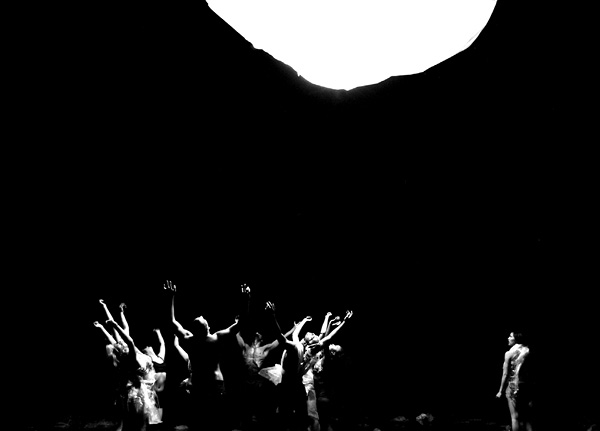
SACRAMENT
first performed on
March 9, 2011
Sharon Disney Lund Dance Theater, Valencia, CA
performed three times in 2011
NATALIE METZGER & ROBERT ALLAIRE
Los Angeles, CA
086327462n086327462a086327462t086327462a086327462l086327462i086327462e086327462@086327462m086327462e086327462t086327462z086327462a086327462r086327462t086327462.086327462o086327462r086327462g
metzart.org
SACRAMENT
NATALIE METZGER & ROBERT ALLAIRE
“Sacrament” is a dance theater experience set in a landscape of decay in which a god is created and destroyed through a cult ritual. The work examines cult mentality, the evolution of god, and the human attraction to violence. The primary goal of “Sacrament” was to create an immersive audience experience that would make the audience active witnesses and participants in the work instead of passive observers. This was partly accomplished by removing the traditional theatrical conventions that have become defaults in concert dance.
These conventions were subverted from the moment that the audience entered the theater, not through the public entrance, but through the back of the building where elephant doors opened onto a long, dark hallway. The hallway opened into a cavernous room that was filled with an immense, plastic “sac” that hung from the ceiling with tendrils that invaded the space. This set became the deity character that the performers worshipped, and it moved and responded to their actions. Each of the theatrical elements was diegetic-the music became the god’s voice and the sound of its body, the lighting and projection made the deity glow and flicker, and the stripping and donning of costumes were an integral part of the cult ritual. The whole space was a performance area, leaving no separation between audience and performer. The normal seating of the theater was removed, and the floor was strewn with overturned chairs. The audience could turn the chairs upright and sit wherever they wanted, or they could stand or sit on the ground, but they were completely surrounded by the created world.
Direct interaction between audience and performer was extremely important to the immersive experience. Instead of ignoring the audience’s existence, the performers acknowledged the audience as other people in the created world, and at different moments, individual performers would break off from their task or ritual and interact with audience members, examining them, prodding them, or perhaps offering them a chair. During some of these encounters, the performers would surround an individual audience member, violently drag them out of their chair, and pull them into the performance. These chosen audience members were actually performers that had entered as audience members, but to the audience, it seemed as if they themselves might at any moment be chosen and dragged into the ritual, their very act of voyeurism making them feel complicit in the violence.